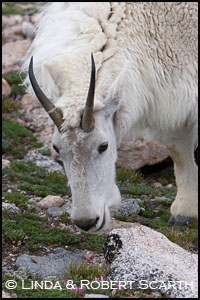introduction - galleries - technique - catalogue - notes - links - contact - blog - deep nature

Mountain Goat
It is not often that photographers get to follow a mixed flock of Bighorn Sheep and Mountain Goats up a mountain road, meeting the flock at the switchbacks to make images and then have them reappear again at the parking lot at the top. What was meant to be a quick side trip up the Mount Evans Byway, about 50 miles southwest of Denver and the highest paved road in the lower 48, provided the subjects of this essay. The 14,264 foot (4,350 meters) summit, with its ease of access and the chance to find sheep or goats, is both an opportunity and a hazard, especially for flatlanders who do not take the time to stage their descent above 2,500m (8,000 feet) elevation.
When we head for the mountains we usually take several days moving up to the high country as is recommended to avoid Acute Mountain Sickness (AMS). With summer coming and travel to the mountains so popular, we thought we would offer a word of caution to photographers and casual travelers alike. We had time for a short trip two summers ago to photograph wildflowers at Crested Butte, CO. It was 100 degrees in Omaha when we stopped at the zoo on Saturday afternoon. Twenty-four hours later we were headed up the much cooler Mount Evans Byway for a short stop at the top. The lambs, kids and their mothers changed our plans, our trip itinerary and our respect for the effects of AMS. We did not intend to stay up there so long that day nor to camp at 10,000 feet altitude the first night in the mountains.
AMS is a set of symptoms that vary from the uncomfortable to the dangerous. About 25 percent of people will get some symptoms when they go to Colorado mountain ski resorts ? up to 3,000 meters. The higher the elevation, the greater the incidence. At above 10,000 feet (3,000 meters), 75 percent will have some symptoms. The common symptoms are headache, fatigue, dizziness, shortness of breath and possibly nausea and trouble sleeping. A throbbing headache that is not cured by an analgesic and drinking water to rehydrate may be caused by the further decrease in oxygen and air pressure as one ascends. Sometimes we have seen people carrying droopy children coming back from short nature walks at parking areas in the high mountains. Those youngsters probably are suffering from AMS.
Other worsening symptoms are high altitude cerebral edema (HACE) and high altitude pulmonary edema (HAPE). HACE is the build up of fluids within the skull and HAPE is the leakage of fluid into the lungs. Most symptoms usually subside after descending to lower elevations but HACE and HAPE often need medical attention and can be life threatening, especially if complications occur.
The best cures are the precautions. Take several days to move up to high altitudes. Drink lots of water. Don?t rush. Rest often. When photographing or exploring above 9,000 feet, sleep at lower elevations. If you have the symptoms, head down hill.
As we followed the flock up Mount Evans, we were struck by both the combination and segregation in the group. The kids and lambs played but never with the other species. The lambs were much more wary than the kids. At the top we learned the reason for their beeline to the top. Adults and youngsters alike licked the ground in one area for minerals and nibbled on the owl clover blossoms. The licking lasted about an hour. They did not seem much interested in all the people admiring them. The kids in particular, not being able to read the sign prohibiting climbing, played on the walls of a historic building ruin there at the top. They also became ?puffed? as they played king on the hill on boulders. It was almost dark when we pulled into the campground that night.
We were aware of the reduced oxygen if we moved too quickly as we camped above 10,000 feet over the next several days. There are just over half of the oxygen molecules present at 14,000 feet as there are at sea level. The reduction in air pressure not only caused us both to develop some pulmonary edema after several days, it also made several yoghurt containers explode in our pickup camper refrigerator. Our headaches and coughing prompted us to get medical care when we reached Crested Butte. Nebulizers, antibiotics and rest enabled us to camp along the Cement Creek and Slate River and photograph wildflowers for several days before heading home. It took several weeks before we were really well but the experience with Mountain Goats and Bighorn Sheep was worth it.
? Linda & Robert Scarth, 2007.
First published in NatureScape News, 2 (4), 6, 2007.
